DWP single departmental plan: 2015 to 2020
Updated 20 April 2017
£6bn Total Departmental Expenditure Limit (DEL) in financial year 2015 to 2016
This includes £5.8 billion Resource DEL and £0.2 billion Capital DEL. In addition, DWP Annually Managed Expenditure (AME) in financial year 2015 to 2016 is £170.5 billion, as forecast by the Office for Budget Responsibility.
Source: Spending Review and Autumn Statement 2015
Source: Office for Budget Responsibility Economic and Fiscal Outlook 2015
Vision
Everything we do in the Department for Work and Pensions is about providing security, extending opportunity, and giving people the support they need to transform their lives.
We are helping the most vulnerable people in our society by addressing the root causes of disadvantage and supporting them to turn their lives around.
We are ensuring that everyone who is able to work is given all the support they need to do so, while those who cannot are – quite rightly – protected.
Through Universal Credit we are delivering a benefit system that provides the right incentives, ensures work always pays, and which supports people both to get a job and then to progress in employment.
We are giving people greater security, choice and dignity in retirement with a safe and sustainable State Pension, and the independence of a well earned private pension.
Objectives
Our Permanent Secretary’s objectives
Progress against this plan will be measured in the Annual Report and Accounts.
1. Run an effective welfare system that enables people to achieve financial independence by providing assistance and guidance into employment
Lead minister: Damian Hinds MP, Minister of State for Employment
Lead official: Jeremy Moore, Director General, Strategy, Policy and Analysis
1.1 What DWP is doing
We are transforming people’s life chances by supporting them to become sustainably employed and increase their earnings. This is key to our ambition to have the highest employment rate in the G7. We are pursuing this by:
- continuing to roll out Universal Credit through to financial year 2020 to 2021 and extending job search conditionality to a further 1.3 million claimants to ensure that work always pays
- continuing to provide a range of employment support through Jobcentre Plus, the Work Programme (until 2017) and the new Work and Health Programme from 2017
- supporting people to become self-employed (New Enterprise Allowance)
- offering working families on Universal Credit support of up to 85% of their eligible childcare costs (where the lone parent or both parents in a couple are in work)
- helping parents understand the government’s childcare offer
We will make progress towards our ambition to halve the disability employment gap by supporting disabled people and people with long term health conditions to get in and stay in employment. We are doing this by:
- reforming the welfare system to support people with disabilities and health conditions into work, whilst protecting the most vulnerable – we will be publishing a Green Paper in 2016 that will set out plans to improve support for people with health conditions and disabilities, including exploring the roles of employers, and promoting integration across health and employment
- continuing to provide specialist provision for people with health conditions and disabilities within Jobcentre Plus, the Work Programme and Work Choice until 2017
- introducing a new Work and Health programme from 2017, which we will work with local partners to deliver, which will provide specialist support for claimants with health conditions and disabilities and those unemployed for over 2 years
- providing a more personalised and improved service offer within Universal Credit ensuring that work always pays
- supporting employers to recruit and retain disabled workers through initiatives such as Disability Confident
- providing in work support for disabled people through Access to Work
- supporting employees who are off sick from work to return through the Fit for Work service
- improving access to health treatments including investing an additional £600 million in mental health services
- improving links between health services and employment support through a Joint Work and Health Unit
We are supporting young people to find work whilst making progress towards our ambition to abolish long term youth unemployment by:
- introducing Youth Obligation through Universal Credit from 2017 which will include intensive support for those 18 to 21 year olds who we expect to look for work from when they first claim and requiring those still out of work after 6 months to apply for an apprenticeship, a traineeship, gain work-base skills or take up a work placement
- introducing Jobcentre Plus support into schools in England to supplement careers advice and provide routes into apprenticeships, work experience and sector-based work academy places
We are supporting the Prime Minister’s ambition to increase the number of workers from ethnic minority backgrounds in employment by 20% by 2020, by:
- identifying and sharing good practice in jobcentres to support people from ethnic minority backgrounds into employment
- working with exemplar employers to learn how they encourage diversity in their organisations
We are supporting increased labour supply and retirement incomes through employer-led initiatives on fuller working lives, ensuring older people do not leave the labour market early through:
- avoidable medical retirement
- inability to balance caring responsibilities with employment
- the need to re-skill or change occupations
1.2 How DWP is doing
UK employment rate 74.6% between October and December 2016
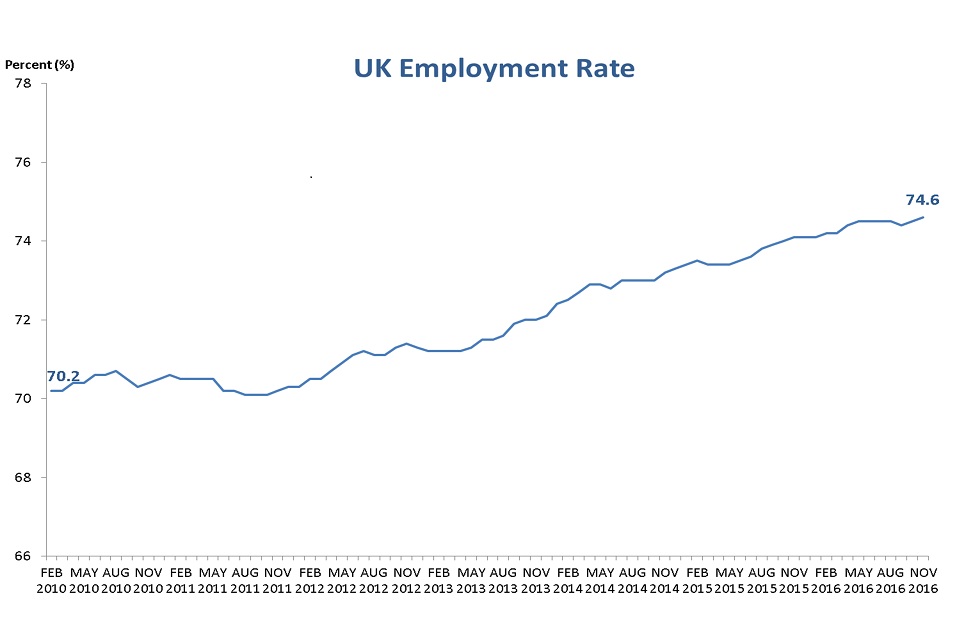
The overall UK employment rate reached a new record high of 74.6% between October and December 2016, up 1.1 percentage points from January to March 2015 (our baseline period for this Parliament) and up over 4 percentage points since 2010.
Source: Labour Market Statistics published by the Office for National Statistics.
Employment rate for disabled people 49.6% between October and December 2016
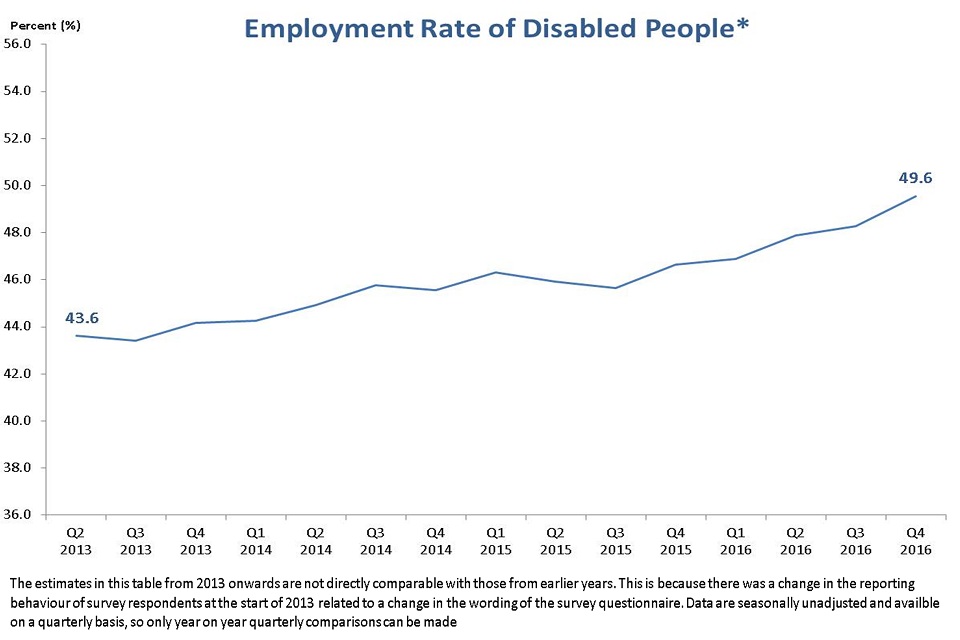
The employment rate for disabled people between October and December 2016 was 49.6%, up over 5 percentage points over the last 3 years, from 43.2% in the same quarter in 2013. The rate is up nearly 3 percentage points over the last year.
Source: Labour Force Survey published by the Office for National Statistics
Percentage of young people not in full-time education in employment 76.5% between October and December 2016

76.5% of young people not in full-time education were in employment between October and December 2016 compared to 74.2% in January to March 2015 (our baseline for this Parliament), and up over 8 percentage points from 68.3% in January to March 2010.
Source: Labour Force Survey published by the Office for National Statistics.
Number of people on key out-of-work benefits 3.70m in August 2016
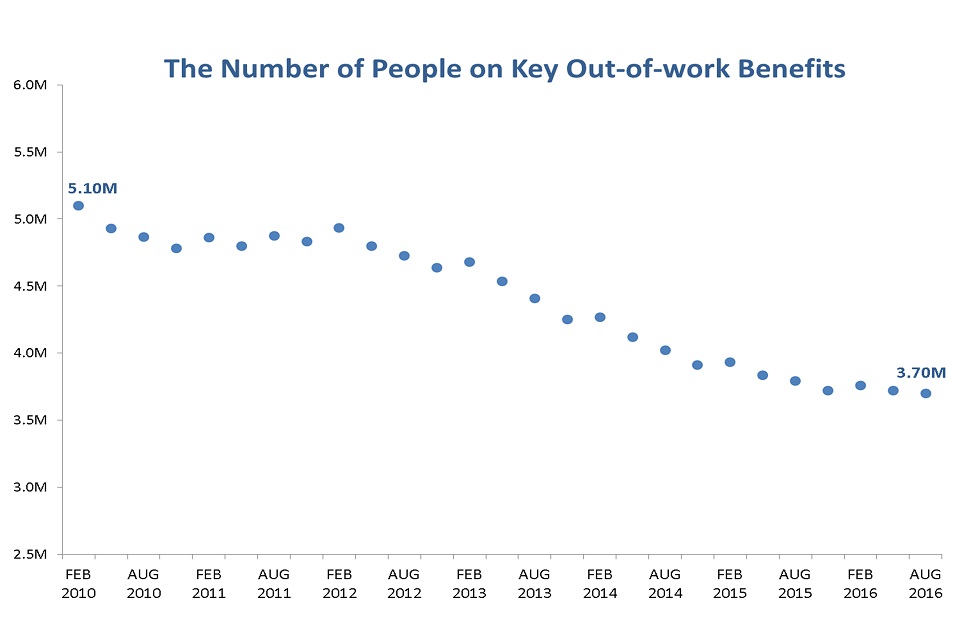
The latest data show that a total of 3.70 million people aged 16 to State Pension age claimed a key out of work benefit in August 2016. This has fallen by around 92,000 from 3.79 million in August 2015 and fallen by over a million from 4.87 million in August 2010. Due to seasonal movements in benefit claiming patterns only year on year comparisons can be made.
Source: Work and Pensions Longitudinal Study and ONS Claimant Count.
2. Increase saving for, and security in, later life
Lead minister: Richard Harrington MP, Parliamentary Under Secretary of State for Pensions
Lead official: Jeremy Moore, Director General, Strategy, Policy and Analysis
2.1 What DWP is doing
We are providing greater security, choice and dignity for people in retirement, while also ensuring the system is sustainable for the future.
To give everybody the confidence that they will receive a decent State Pension, we are:
- putting the State Pension system on a fair and sustainable basis, giving people greater understanding and confidence through the introduction of the new State Pension
- continuing to support current pensioners through the triple lock, and by protecting universal pensioner benefits in the UK such as Winter Fuel Payment
- giving those not eligible for the new State Pension the opportunity to ensure a decent retirement income through State Pension top-up
- giving people security in their retirement income by paying State Pension and other pensioner benefits (£94.5 billion in financial year 2014 to 2015)
We are helping working people save for a private pension and giving them the freedom to access their pension pots in the best way for them by:
- completing the roll out of Automatic Enrolment to small and micro businesses, giving all eligible employees the opportunity to enrol into a workplace pension and save for their retirement
- removing the restrictions on how people access their private pension pots, giving people aged 55 and over greater choice in how to spend their well-earned savings
- protecting savers by working with HM Treasury, Pension Wise, the Pensions Regulator and Financial Conduct Authority to monitor the products, charges and processes affecting individuals accessing their private savings
- giving savers the confidence to save and access their pension pots by providing more information on pensions through the Pensions Advisory Service, Pension Wise, pension forecasts and pensions tracing
- working with employers and stakeholders to give people the opportunity to work and to save for as long as they wish
2.2 How DWP is doing
Pension scheme membership 15.1m eligible employees in a pension scheme

The number of eligible employees in a pension scheme sponsored by their employer in 2015 was 15.1 million. This represents a 4.4 million increase from 10.7 million in 2012.
Source: Annual Survey of Hours and Earnings (ASHE)
Percentage of pensioners with a low income 16% in financial year 2015 to 2016

Percentage of pensioners with a low income was 16% in financial year 2015 to 2016. Living standards for pensioners have been rising steadily for many years. Despite the latest rise in relative low income (not statistically significant), the proportion of this group living in a low income household is still low in historical standards.
Source: Households below average Income
3. Create a fair and affordable welfare system which improves the life chances of children and of adults
Lead minister: The Rt Hon Damian Green MP, Secretary of State for Work and Pensions
Lead official: Jeremy Moore, Director General, Strategy, Policy and Analysis
3.1 What DWP is doing
We are managing welfare expenditure by implementing the measures announced in the Budget 2015, to reduce the cost of the welfare system by £12 billion by 2019 to 2020, while protecting the most vulnerable, including:
- lowering the amount of benefits a household can receive out-of-work to £23,000 in Greater London and to £20,000 for residents elsewhere (with exemptions to protect the most vulnerable)
- ensuring 18 to 21 year olds, who are out of work, no longer have automatic entitlement to support with housing costs from April 2017 (with exemptions to protect the most vulnerable)
- freezing the rates of working age benefits and tax credits for 4 years from April 2016 (with exemptions to protect the most vulnerable)
We are also:
- taking action to manage expenditure within the welfare cap
- further reforming welfare rules so that European Union jobseekers can no longer access UK means-tested benefits (from June 2015 we have ended European Union jobseekers’ entitlement to Universal Credit)
- reducing immigration by cutting the benefits European Union migrants get so we prevent the welfare system acting as a magnet and create a fairer system for people who work hard and play by the rules
We are supporting disabled people to live independently by:
- replacing Disability Living Allowance with Personal Independence Payment (PIP) – we have introduced PIP, which is designed to better reflect today’s understanding of disability, particularly on mental health and fluctuating conditions, and to focus support on those in greatest need; PIP is exempt from the benefit freeze over the life of the Parliament and is also exempt from the benefit cap
- paying disability and carers’ benefits (£23.1 billion in financial year 2014 to 2015)
We are improving the life chances of children and of adults by:
- developing a Life Chances Strategy, which will set out a comprehensive plan to fight disadvantage and extend opportunity so that every child can reach their full potential
- introducing new life chances measures on worklessness and educational attainment, along with other measures of the root causes of poverty including, family stability, drug and alcohol dependency and financial stability
- encouraging family stability, by improving the availability of support for couples (we will spend over £70 million this Parliament, exceeding the manifesto commitment to invest at least £7.5 million in relationship support), developing a significantly expanded parenting programme, and implementing reforms to the Child Maintenance Service to encourage family based arrangements where appropriate
We are working closely with all the nations within the UK, in particular where areas of policy are closely linked, and particularly with the Scottish government on how newly devolved powers will work in practice, as part of this we are:
- working with the Scotland Office to implement recommendations of the Smith Commission relating to DWP policy through delivery of the Scotland Bill, which includes devolving powers to the Scottish government to deliver a range of benefits and employment support
- supporting the principle of localism, working with local authorities, community groups and charities to join up delivery
3.2 How DWP is doing
Forecast welfare spending within the welfare cap
At Autumn Statement 2016 a new welfare cap was set for 2021 to 2022 only, with a pathway for spending in prior years. The new welfare cap will be formally assessed at the start of the next Parliament.
Source: Office for Budget Responsibility
Percentage of children living in workless households 10.7% in October to December 2016
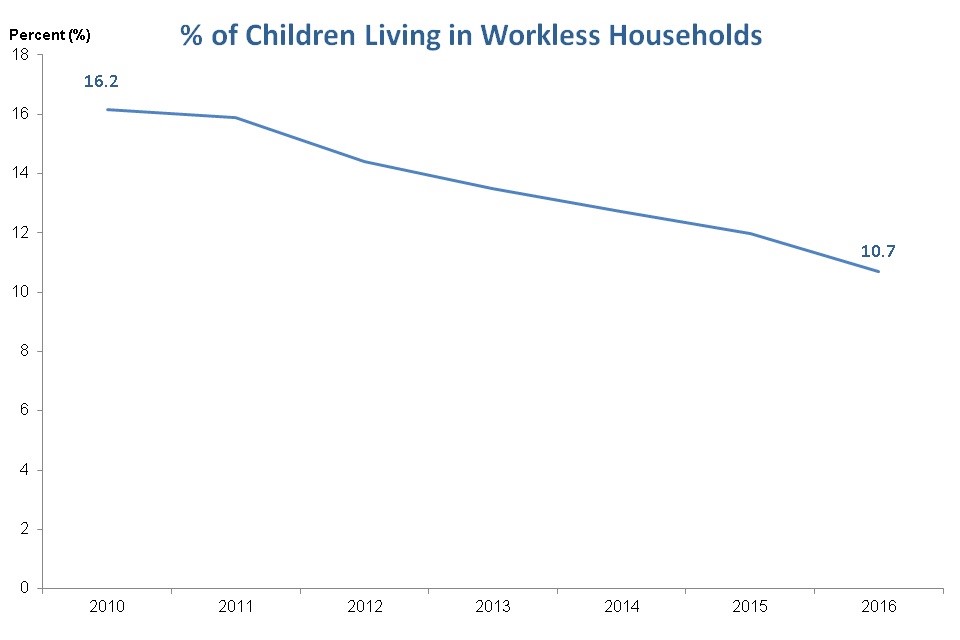
In 2016 (October to December) the percentage of children living in workless households was 10.7% – an improvement from 16.2% in 2010 (October to December).
Source: The Household Labour Force Survey
4. Deliver outstanding services to our customers and claimants
Lead minister: Lord Freud, Minister of State for Welfare Reform
Lead official: Andrew Rhodes, Director General, Operations
4.1 What DWP is doing
We deliver essential services for welfare, pensions and child maintenance. We are continually seeking to deliver outstanding services by:
- streamlining our business processes and simplifying our communications
- improving the timeliness and accuracy of benefit processing
- ensuring our digital technology and data services are easy to use, stable and secure
- ensuring we have an engaged and committed workforce
4.2 How DWP is doing
Customer and claimant satisfaction of DWP services (%) 84% overall customer satisfaction rating, in financial year 2015 to 2016

Latest data shows we achieved an overall customer and claimant satisfaction rating of 84% in 2015-16, an improvement of 2% on last year’s score.
Source: Claimant Service and Experience Survey 2011, 2012, 2013, 2014 to 2015.
Benefits processed within planned timescales 90% of key out of work benefits processed within agreed timescales, in financial year 2015 to 2016
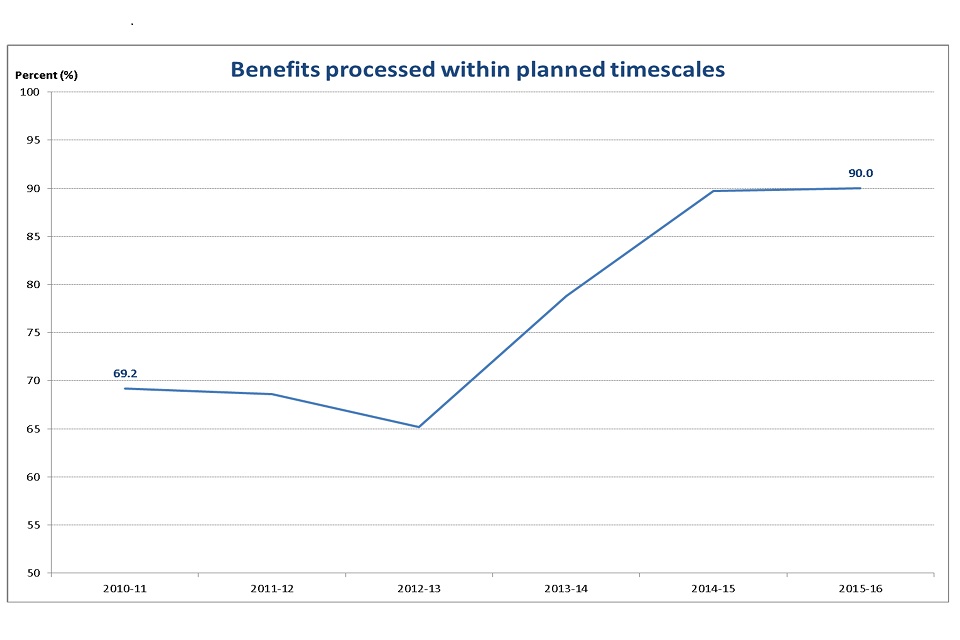
In 2015/16 the percentage of key out-of-work benefits processed within agreed timescales was 90%. An improvement on previous years.
Source: DWP Management Information Systems Programme.
Net benefit overpayments as a percentage of overall benefit expenditure 1.3%

In 2015/16 the estimated level of net overpayments arising from fraud and error, after debt recovered has been offset, was 1.3%, which is lower than the 1.7% in 2010/11.
Source: Fraud and Error in the Benefit System
5. Delivering efficiently: transforming the way we deliver our services to reduce costs and increase efficiency
Lead minister: Caroline Nokes MP, Parliamentary Under Secretary of State for Welfare Delivery
Lead official: Peter Schofield, Director General, Finance
5.1 What DWP is doing
We are committed to ensure value for money for the taxpayer by reducing our operating costs over the Parliament, whilst continuing to improve the efficiency and effectiveness of our services by:
- continuing to redesign our customer services, increasing the use of digital services, streamlining and automating back-office processes
- harnessing data and analytics to make better business decisions more quickly
- establishing more flexible, cost-effective contracts with IT suppliers, including contracts with small and medium sized businesses
- investing in a smaller and more skilled workforce and building our technology and commercial capability
- reducing our estate and increasing the number of job centres co-located with partner organisations such as local authorities
- targeting and reducing spend on contracted employment programmes
- reducing fraud and error while maximising debt recovery
- securing efficiencies from our arm’s length bodies
Progress against our ambition to reduce DEL expenditure of 14% in real terms will be published in our Annual Report and Accounts.
5.2 How DWP is working collaboratively across government
We will work collaboratively with Cabinet Office, HM Treasury and other government departments to deliver transformational change in key areas, including:
- developing digital solutions that meet common standards set by the Government Digital Service and utilise cross government platforms wherever this demonstrates the best value money solution for government
- rationalising our estate using ‘government hubs’ with other departments and local authorities, releasing land for housing where possible, and participating in the development of the new commercial property model
- delivering savings in our commercial relationships including through spend on common goods and services, in partnership with the Crown Commercial Services; continuing to build our commercial capability and working with the Crown Commercial Services to deliver the government’s 33% commitment of our spend with small and medium sized enterprises by 2020
- working in partnership with the Cabinet Office to deliver arm’s length bodies transformation plans and Infrastructure and Projects Authority on major projects, programmes and prioritisation
